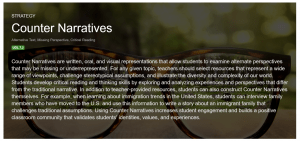Digital Literacy Narratives function as a powerful tool for writing instruction. Instead of teaching narrative writing in isolation, educators can modify instruction to elevate regular narratives to digital literacy-focused narratives. These narratives serve multiple functions: they allow for students to explore and confront their own literacy practices, giving them the language and experience to tell their own stories, as well as create a class-wide narrative in a digital archive. Digital Literacy Narratives incorporate student identity the most by providing students will opportunities to draw upon their common literacy practices, including those gained through social media. Just as students generate profiles and participate in networked publics relevant to their constructed identities, digital narratives also provide a forum for students to present themselves in their own manner.
Where digital narratives differ – and perhaps rule over – from social media is in the restrictive elements. Digital narratives, outside of classroom assignment requirements, can allow much more  freedom for students to explore their “performances of identity” (Selfe). Without having preestablished “norms” and behaviors for students to follow, as social media lends itself to, digital narratives allow students to explore their individual stories. Once they are completed and compiled into a digital archive, then they are exposed to other students’ experiences, narratives, and performances, creating a much more organic communication. Further, just like social media, digital narratives allow students to claim ownership over their stories and experiences (Bloome). Students choose a “story to tell (or not to tell) and details to represent (or not represent)” just like what aspects of their identity or bedroom walls they depict in their social media accounts (Selfe). The connections that students can generate between narrative writing and their social media practices can be enhanced by this shift in approach to narrative writing. In addition, it allows students – just like with ePortfolios – an opportunity to focus away from the “clarity” and formality of academic writing (Klein 60). They are
freedom for students to explore their “performances of identity” (Selfe). Without having preestablished “norms” and behaviors for students to follow, as social media lends itself to, digital narratives allow students to explore their individual stories. Once they are completed and compiled into a digital archive, then they are exposed to other students’ experiences, narratives, and performances, creating a much more organic communication. Further, just like social media, digital narratives allow students to claim ownership over their stories and experiences (Bloome). Students choose a “story to tell (or not to tell) and details to represent (or not represent)” just like what aspects of their identity or bedroom walls they depict in their social media accounts (Selfe). The connections that students can generate between narrative writing and their social media practices can be enhanced by this shift in approach to narrative writing. In addition, it allows students – just like with ePortfolios – an opportunity to focus away from the “clarity” and formality of academic writing (Klein 60). They are  instead able to focus on their own personal connections, experiences, and stories; thus, they are able to engage with the assignment more. It becomes more relevant to their lives, in which they possess an intrinsic motivation to produce a meaningful narrative.
instead able to focus on their own personal connections, experiences, and stories; thus, they are able to engage with the assignment more. It becomes more relevant to their lives, in which they possess an intrinsic motivation to produce a meaningful narrative.
For more reading on Digital Literacy Narratives, check out:
DLAN, Stories that Speak to Us https://ccdigitalpress.org/book/stories/
Back to Educational Applications
Back to Final Project Homepage
